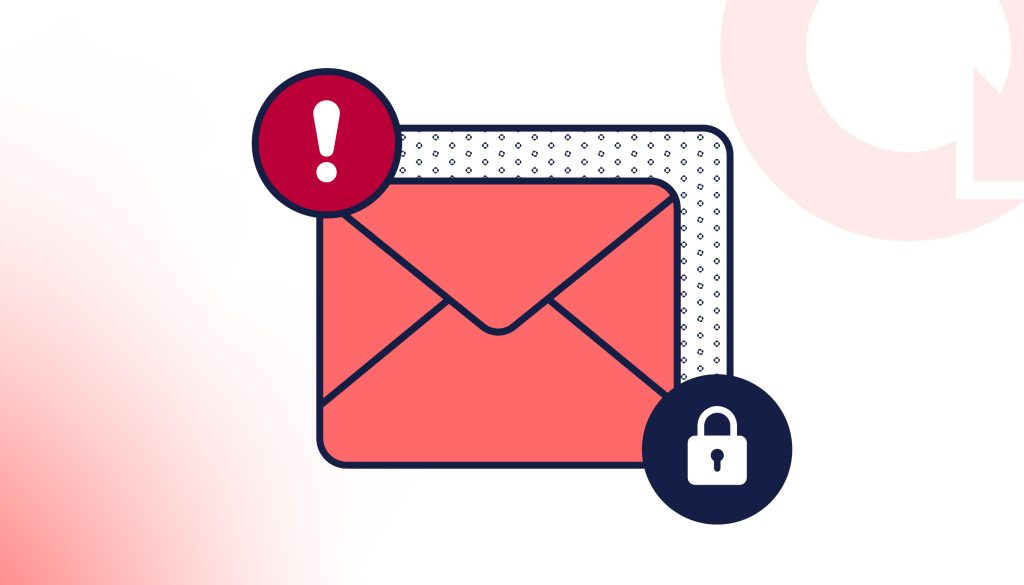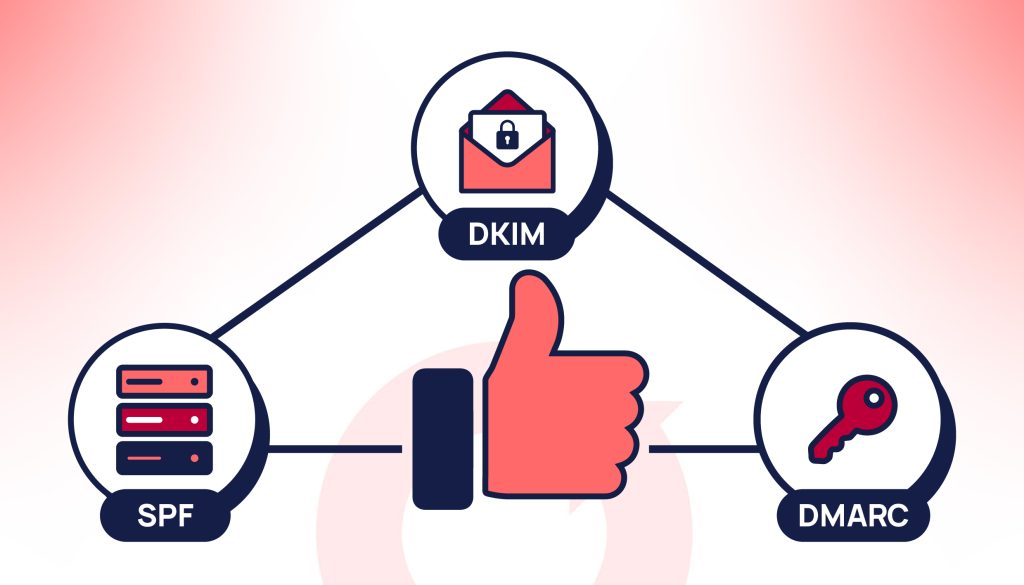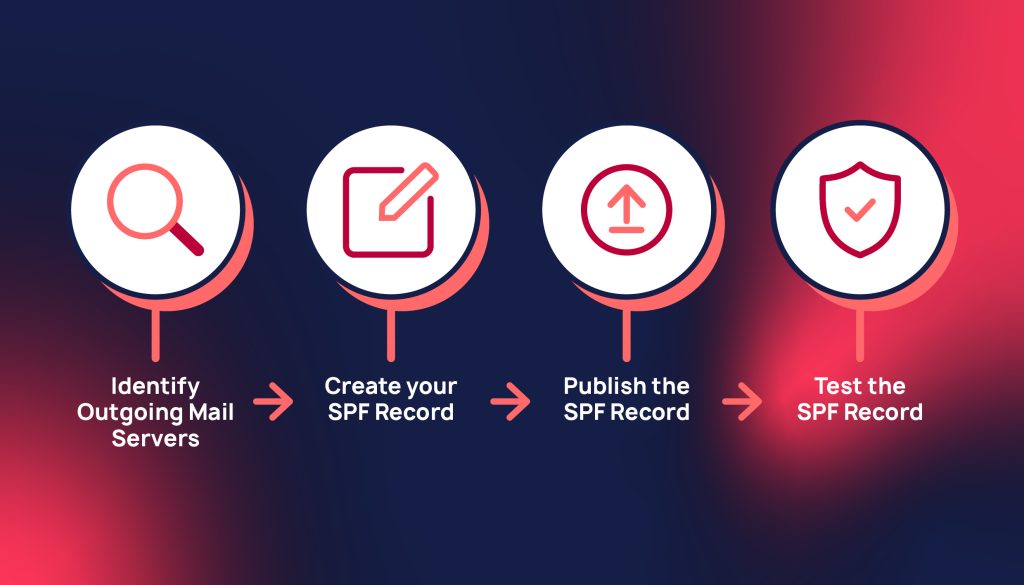 Email icon with an exclamation point and the lock icon
Email icon with an exclamation point and the lock iconThere’s really no doubt that email is a vital tool for any business’ marketing endeavor, making it even more essential to up the security to ensure you’re protecting your communications with clients and partners from phishing attempts and spam.
These cyberthreats are pervasive and can potentially clutter your inbox—misdirecting and confusing you from your more important emails on top of providing the risk of the risk of getting lured into their scams.
By implementing sound email authentication measures, you’re putting yourself in a better situation of protecting your mail list from these threats and getting all your legitimate emails sorted out as priority for future marketing plans at the same time!
It’s really as simple as it gets, and as soon as you learn the bells and whistles of email authentication, the sooner you’ll safeguard your business email to help your business thrive even more!
Why Email Authentication is Critical
 Critical SPF DKIM DMARC pyramid
Critical SPF DKIM DMARC pyramidBefore even delving deeper into email authentication, what even is it to begin with? Email verification simply verifies what authorized emails are sent from a domain’s owners. It primarily uses three mechanisms:
- SPF (Sender Policy Framework)
- SPF allows senders to define which IP addresses are allowed to send mail from a particular domain. This means that this mechanism gives you the authority to handpick the safe devices from anywhere in your business to get access to your email files.
- DKM (Domain Keys Identified Mail)
- DKIM is in charge of validating the email content through a digital signature to ensure that these emails aren’t malicious of any kind. In other words, it checks for any doubtful and suspicious links, files, and content within the email itself.
- DMARC (Domain-based Message Authentication, Reporting and Conformance)
- DMARC is simply the mediator of both SPF and DKIM that sets policies to ensure that it consistently and continuously improves handling fraudulent mail.
With all three together working in harmony, email authentication creates a safe environment for your business. In fact, recent studies show that implementing DMARC can stop 90% of email phishing attempts, and companies that use SPF and DKIM significantly reduce spam score for their emails and enhance deliverability by over 40%.
One great example of this is when the Bank of America implemented DMARC, they saw an 80% reduction in phishing attacks targeting their customers. It just goes to show that email authentication can go a long way, regardless of a business’ size and position in the market—be it a startup or a well established entity such as the Bank of America itself.
However, email authentication isn’t perfect and is still seeking to improve to have the means of securing email accounts from these threats—which is why major email hosts like Google and Yahoo have continuously set new email authentication requirements.
Also, cybercriminals are also adapting to the newer protocols and requirements which put a toll on sites like Google and Yahoo to up their safety software in regards to email integrity and deliverability. It’s especially critical in the digital landscape as a whole where email compromises are a top vector for security incidents to start with.
Implementing SPF: Your First Step Towards Secure Email
 Step-by-step guide to authenticating email
Step-by-step guide to authenticating emailSender Policy Framework (SPF) is an email authentication method designed to prevent sender address forgery. Here’s how to set it up:
- Identify Outgoing Mail Servers: List all the servers that send emails on behalf of your domain.
- Create Your SPF Record: This is a TXT record in your domain’s DNS settings. The record starts with v=spf1, followed by the servers you identified. For example:
- v=spf1 ip4:192.168.0.1 include:_spf.google.com ~all. This SPF record allows emails from the IP address 192.168.0.1 and emails sent through Google’s servers, while emails from other sources will be softly failed (~all).
- Publish the SPF Record: Add this TXT record to your domain’s DNS configuration.
- Test the SPF Record: Use SPF validation tools available online to ensure it’s correctly set up.
These steps are crucial for preventing email spoofing where attackers send emails from a forged address to trick recipients. Implementing SPF correctly can significantly decrease the likelihood of your domain being used for spam and phishing attacks, as illustrated in the diagram below:
Implementing SPF is just the beginning. To fully secure your email, consider integrating SPF with DKIM (DomainKeys Identified Mail) and DMARC (Domain-based Message Authentication, Reporting and Conformance) protocols. These additional layers work together to enhance email security, provide better protection against fraud, and improve email deliverability.
Sealing Your Email with DMARC
Setting up DMARC involves a few critical steps:
- Verify SPF and DKIM Records: Before setting up DMARC, ensure that SPF and DKIM are correctly configured and published for your domain.
- Create Your DMARC Record: Start with a policy that doesn’t affect your traffic but monitors it: v=DMARC1; p=none; rua=mailto:[email protected] This record sets the DMARC policy to ‘none’ (monitoring mode), enabling you to receive reports without affecting your email flow.
- Publish the DMARC Record: Add the DMARC record as a TXT entry in your domain’s DNS settings.
- Analyze Reports: Monitor the aggregate reports sent to the specified email to understand how your emails are being handled and verify if legitimate emails pass the DMARC check.
- Adjust Your Policy: As you gain confidence in your email authentication setup, adjust the DMARC policy to ‘quarantine’ or ‘reject’ to provide stricter control over unauthenticated emails.
Conclusion
There’s more good to going through the steps of authenticating email than not when you are exposed to the risks of having important files and messages compromised by cyberattacks. Luckily, understanding email authentication isn’t rocket science, and any business owner can go through this process to ensure that your company will thrive unscathed from the horrors of email scams and phishing attacks that are incredibly prominent in the digital world today.
Going With Retention Hero
Needing help on email authentication for your marketing campaigns? If so, then we got you
covered! Our expert marketing team and consultants will provide you with the marketing
strategies to effectively grow your business!
Retention Hero isn’t just about driving results—it’s about safeguarding your business with top-
notch email authentication services. Our expert team ensures your emails are protected from
phishing and spam, giving you peace of mind and allowing you to focus on what matters most:
growing your business. Join us today and experience the difference that a secure email
environment can make!